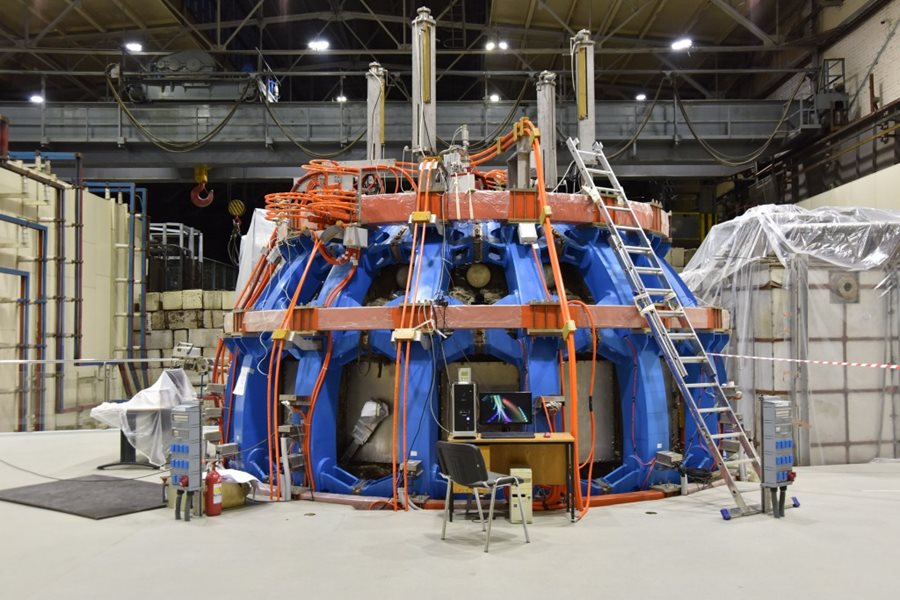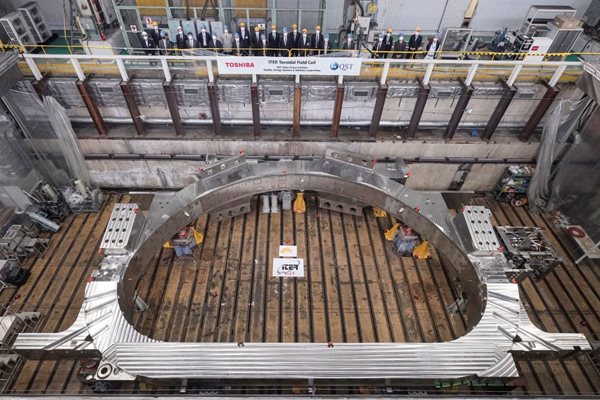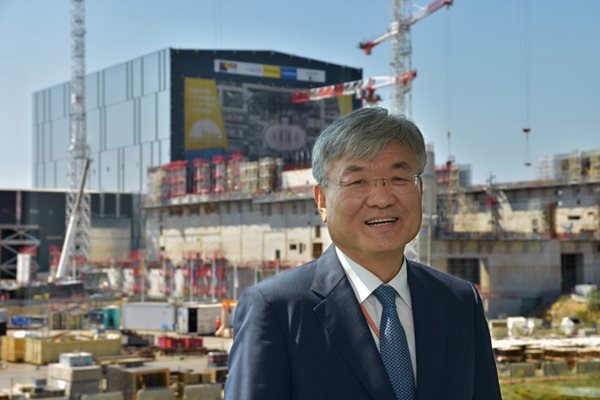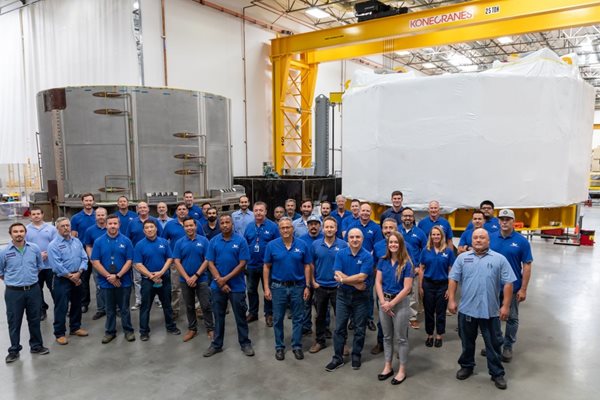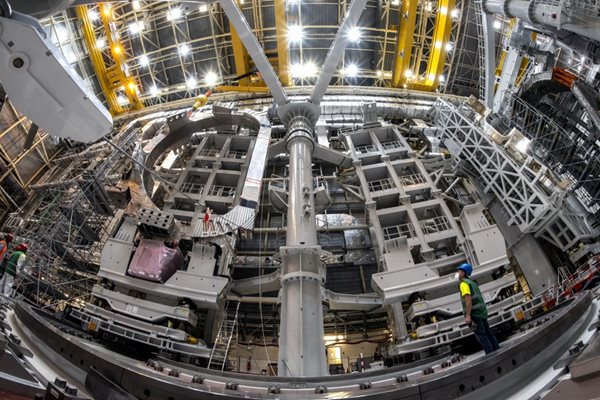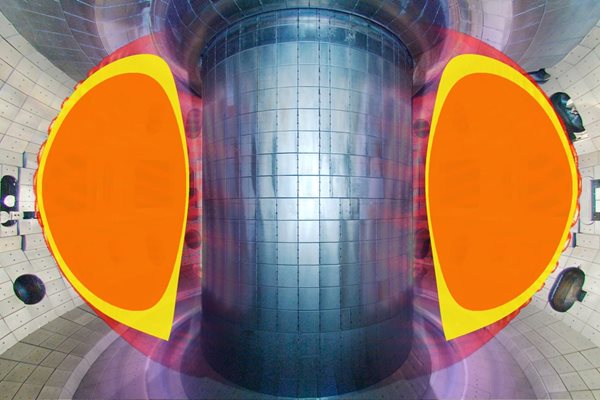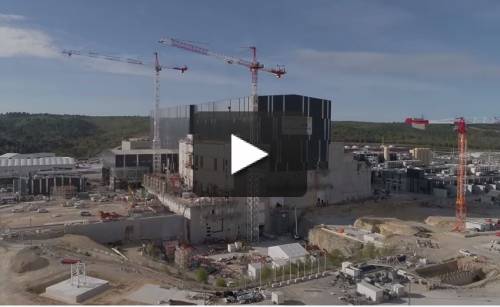
you're currently reading the news digest published from 07 Jun 2021 to 15 Jun 2021
featured5
of-interest1
video1
press38
featured
Fusion world | T-15MD comes on line in Russia
Sixty-three years after a team at the Kurchatov Institute in Moscow built the world's first tokamak, experiments are slated to begin there on a new machine, T-15MD. This versatile, mid-sized device is designed to support preparations for ITER operation, but not only. In Moscow on 18 May, participants to the T-15MD launch ceremony lauded the start of the 'first new fusion installation at the Kurchatov Institute in 20 years.' Russian Prime Minister Mikhail Mishustin and Mikhail Kovalchuk, President of the Kurchatov Institute, pressed a symbolic start button and spoke over video link with Bernard Bigot, the Director-General of the ITER Organization, who congratulated them on the facility's launch. T-15MD is a new machine created in the place of the T-15 tokamak—Russia's second superconducting tokamak (after T-7), which operated at the Kurchatov from 1988 to 1995. The original machine was entirely disassembled in 2017 and all major components were modernized, from auxiliary plasma heating and current drive systems to the new, non-superconducting silver-copper magnet systems and graphite inner surfaces. The upgraded Russian tokamak will extend the operational domain of "ITER-complementary' machines, with an experimental program that will contribute to the determination of optimal operating parameters for ITER and for future fusion reactors. The T-15MD tokamak can obtain elongated one- and two-zero divertor configurations of a plasma column, with an aspect ratio* in the range of 2.2 to 3.1 and elongation up to 1.9. Its water-cooled electromagnetic system is capable of creating a toroidal magnetic field at the plasma axis of 2 T; it also has powerful quasi-stationary additional heating systems with a total power input into the plasma up to 20 MW, and modern engineering infrastructure. The current in the plasma should reach 2.0 MA with a duration of 10 s. Tokamak T-15MD was built over 10 years (2011-2020). The uniqueness of T-15MD lies in its combination of high power and compact dimensions. High-performing auxiliary plasma heating and current drive systems will allow the simultaneous achievement of high plasma temperature and plasma density, with pulse lengths of up to 30 s. The machine will be a test bed for different auxiliary heating scenarios through its capabilities in neutral beam injection, electron cyclotron resonance heating (six gyrotrons), ion cyclotron resonance heating (three antennas), and low hybrid heating and current drive, as well as a test bed for fusion material studies. The research program on the T-15MD tokamak will be aimed at solving the most pressing problems of ITER, such as the mechanism of formation and maintenance of transport barriers, the stationary generation of non-inductive current, heating and retention of a hot plasma, control of processes on the first wall and in the divertor, and the suppression of global instabilities and periodic energy emissions on the wall. Experiments on T-15MD will also pursue another line of investigation, according to the Kurchatov team—using the neutrons generated in this mid-sized tokamak to explore the feasibility of a hybrid fusion/fission model. In a hybrid model, neutrons generated by the fusion reactions incite fission in otherwise non-fissile fuels contained in the blanket of the vessel. Alternately, they are used to transmutate long-lived high-level waste products from nuclear fission (actinides) into shorter-lived products. 'T-15MD will be the major fusion experiment in the Russian Federation for the next 7 to 10 years,' says Anatoly Krasilnikov, head of the Russian Domestic Agency. 'Its operation will provide support to the ITER Project not only through studies of some aspects of tokamak physics and technology, but also by teaching a new generation of plasma scientists and engineers. In addition, several new fusion plasma technologies important for future reactors, such as a liquid lithium first wall and divertor components and noninductive current drive, will be further developed and studied at T-15MD.' Physical start-up will be pursued through the production of low-temperature plasma demonstrating the operability of all technological systems before a gradual increase in the discharge current and, as a consequence, the plasma temperature. Work with high-temperature plasma on T-15MD will begin late in 2021. * Ratio of the major radius to the minor radius of the toroidal plasma; on ITER the aspect ratio is approximately 3.
Industrial milestone | Toshiba completes ITER coil
Toshiba Energy Systems & Solutions has produced the first of four ITER toroidal field coils on behalf of Japan's QST*, the National Institutes for Quantum and Radiological Science and Technology. The coil will be shipped from Yokohama Port in July. In an event on 7 June 2021, members of the Japanese Diet and senior representatives of the Ministry of Education, Culture, Sports, Science and Technology (MEXT) joined with members of QST, ITER Japan and the ITER Organization to celebrate the achievement. 'Toroidal field coils are among the core components of this tokamak machine. The specifications required for each coil are extremely challenging, and we know how difficult it is to produce a first-of-a-kind component of this size and precision. I sincerely appreciate the tremendous effort and capabilities of the Toshiba team to tackle many technical challenges under these difficult circumstances,' said ITER Director-General Bernard Bigot in his video address, referring to the difficulties the Covid-19 pandemic situation has placed on international manufacturing and shipping. A tokamak uses multiple magnetic fields to influence the path of the plasma. The D-shaped toroidal field coils, which completely enclose the vacuum vessel by matching its shape on both the inboard and outboard sides, are relied on for plasma confinement. In the huge ITER device, a set of 18 coils will produce a total magnetic energy of 41 gigajoules, generating an intense field all around the plasma (11.8 tesla at its maximum) to keep it confined in the centre of the vessel away from the walls. Each coil is made up of a superconducting core wound from 4.57 km of niobium-tin (Nb3Sn) and a surrounding stainless steel coil case. Weighing 360 tonnes each, and measuring 9 x 17 m, they are among the largest components of the ITER machine. Toshiba ESS has developed highly precise processing technology in order to fulfil the requirements of manufacturing ITER toroidal field coils to within an accuracy of millimetres. QST—with the cooperation of Mitsubishi Heavy Industries, Ltd., Mitsubishi Electric Corporation, Hyundai Heavy Industries, and Toshiba Energy Systems & Solutions Corporation—will supply 9 toroidal field coils (assembly of winding packs and coil structures) plus another 10 coil structures to the ITER Project. Toshiba ESS is under contract with QST to manufacture four toroidal field coils and six structural cases. *QST—Japan's National Institutes for Quantum and Radiological Science and Technology—is responsible for all components allocated to Japan by the ITER Organization. Read the Toshiba press release in Japanese or English.
News | G.S. Lee, from KSTAR to ITER to Government
Former ITER Deputy Director-General and Chief Operating Officer, Gyung-Su ("GS") Lee, is the Korean Government's new Vice-Minister for Science, Technology and Innovation. The President of the Republic of Korea, Moon Jae-in, has appointed Gyung-Su Lee as Vice-Minister for Science, Technology and Innovation in the Ministry of Science and ICT (MSIT). He took up his position on Monday 14 June. "The ITER community congratulates Vice-Minister Lee on this wonderful news, and wishes him every success. We look forward to his continued strong leadership in fusion and other leading science and technology advancements," wrote the ITER Director-General, Bernard Bigot, as he communicated the news inside of ITER. Gyung Su Lee is well known in the fusion community for 30 years of unwavering commitment to the development of fusion energy. As President of the National Fusion Research Institute of Korea (NFRI) from 2008 to 2011, he led the development of Korea's superconducting fusion research tokamak KSTAR. He has been closely associated with the ITER Project since 2007, first as Director-General of ITER Korea, then as Chairman of the ITER Management Advisory Committee, Vice Chair of the ITER Council, and finally Deputy Director-General and Chief Operating Officer of the ITER Organization. He has also served as a member of the International Fusion Research Council of the International Atomic Energy Agency, including as Chair. Since leaving ITER in 2020, Mr Lee has held increasingly prestigious positions in the Korean Government, most recently serving as Chairman of the Special Committee on Science and Technology Innovation of the Democratic Party of Korea. In his new capacity, he will lead the Science and Technology Innovation Division at MSIT. According to news reports, this means he will help to set the direction for national R&D investment in the 'digital new deal,' achieving carbon neutrality, and overcoming the current COVID-19 crisis. "Gyung-Su Lee has devoted decades of his professional life toward advancing the cause of fusion energy and the ITER Project," stated Bernard Bigot. "His appointment is a very positive signal for Korea's continuing strong support for the ITER Project."
Industrial milestone | US ITER ready to deliver first central solenoid module
This week the 'beating heart' of ITER—the central solenoid, the largest of ITER's magnets—will take the first step in the final lap of a decade-long journey. Over the next few days, it will be loaded onto a special heavy transport vehicle at General Atomics near San Diego, California, bound for the port of Houston, where it will be re-loaded onto a ship bound for Marseille. By early September, it will reach its final destination, the ITER worksite, where it will meet the rest of the superconducting 'ITER magnet family' and take its place in the machine. Creating the magnetic cage that will shape and control the ITER fusion plasma calls for three primary magnet arrays: the D-shaped vertical array of 'toroidal field coils,' the horizontal layer of ring-shaped 'poloidal field coils,' and the central solenoid positioned in the central axis. The unique role of the central solenoid is to direct a pulse of current in the plasma that circulates around the torus—hence the 'beating heart' moniker. But this is no normal heartbeat. The size and strength of ITER's central solenoid—a stack of six modules, plus support structures, that together boast a height of 18 metres, a weight of more than a thousand tonnes, and a magnetic field strength of 13 Tesla at its core—will enable a current of 15 million amperes in 400-second pulses, more powerful and more sustained than any previous tokamak. To manufacture this behemoth, General Atomics created the Magnet Technologies Center as a fit-for-purpose facility. After a four-year collaboration with US ITER on the design and tooling, fabrication of the first module started in 2015. Each module required more than two years of precision fabrication, carefully winding more than 5 kilometres of steel-jacketed niobium-tin superconducting cable into precise flat discs, then splicing together enough discs to create the full module. Five weeks of heat treatment followed: baking the module evenly in a giant convection-style furnace. Delicately stretching the module coils—much like a giant Slinky toy—allowed the individual turns to be wrapped in fiberglass-Kapton insulation to avoid electrical shorting across the windings. And finally, with the module inserted into a special mould, 3,800 litres of epoxy resin were injected under vacuum, saturating the insulation material, eliminating bubbles, and fusing the module into a structural whole. In February, the first module passed a demanding series of tests; but it waited on standby as the second module was run through a similar series, as an extra precaution to allow any lessons learned to be applied. And now, freshly wrapped for travel over land and sea, Module 1 is heading off to take its place as the first of its kind at ITER. Six more modules (one as a spare) will follow in a series, all of them to be installed in 2023-2024. And not so long after that, ITER's scientists will stand by anxiously as their colossal newborn generates its first heartbeat. To view the making of the central solenoid, see this video from General Atomics. Read more about the fabrication process in this booklet.
Machine assembly | Another faultless sequence
Finalized by Japan in January 2020, delivered to ITER two months later, toroidal field coil #12 (TF12) has moved yet another step closer to its final installation inside the assembly pit as part of the first 'pre-assembly' of the ITER machine. In a series of operations that started on Wednesday 9 June and concluded six days later, the 320-tonne component, securely fastened to the upending tool, was successively tilted 90° in mid-air, re-positioned vertically on the floor, extracted from its massive steel cradle, and eventually attached to the left wing of one the twin sector sub-assembly tools (SSAT-1). The component will remain in this position for about a month, before it is moved to the other sector sub-assembly tool (SSAT-2) for the actual pre-assembly operations. There are several reasons for this temporary stopover: available space in the Assembly Hall is scarce, the upending tool will soon be needed for TF13 (TF12's 'partner' in the first pre-assembly), and the complexity of installing a one-of-a-kind component in a one-of-a-kind tool called for rehearsal in actual conditions. 'In a way, it was a kind of training,' said Head of the ITER Sector Modules Delivery & Assembly Division Chang Ho Choi on Tuesday afternoon as the operation came to a close. Although it was 'a bit longer than anticipated,' the operation was 'quite successful, with no show-stopper, no physical mismatching, and no major adjustments required. It all went very smoothly,' confirms Chang Ho. What took time and required almost a full day of delicate tweaking was the 'balancing' of the load, once it was detached from the upending tool. Although the whole sequence had been practiced with a dummy load whose weight and general shape was representative of a D-shaped 320-tonne toroidal coil, and although models and calculations had determined the coil's theoretical gravity centre, balancing the load was to prove a long and painstaking process. By Tuesday 15 June, six days after operations started, TF12 travelled safely into the left wing of tool #1. In two weeks, TF13 (also from Japan) will be placed in the upending tool to later follow the same sequence of operations, this time directly into SSAT-2. Lessons learned in the present operation will prove priceless. In the course of machine assembly, this very sequence will need to be performed 18 times.
of-interest
"Super-H Mode" shows growing promise at DIII-D
A high-performance fusion regime called Super-H mode is being used on the DIII-D tokamak (US) to test methods to control heat and particle flow at the edge of the fusion plasma. The theoretical model for Super-H Mode was developed several years ago by researchers at General Atomics (which operates DIII-D for the US Department of Energy's Office of Science), the University of York (UK), and the Culham Centre for Fusion Energy (UK). It works by increasing temperature and pressure in the outer region of the plasma, called the pedestal. Higher pressures and temperatures at the pedestal lead to much higher fusion performance in the core. The new approach uses advanced control algorithms and optimized methods of cooling the edge of the plasma without excessively degrading reactions in the core. The results identify a pathway for increased performance at ITER and the fusion power plants that will follow. Read the full press release here. -- Image courtesy of General Atomics.
